

Slim veiligheidssysteem voor extra gemoedsrust.
Adaptive cruise control: wat is het en hoe werkt het.
29 juli 2019
Steeds meer nieuwe modellen zijn leverbaar met Adaptive Cruise Control, ook bij Mitsubishi Motors. Enig idee wat het is en hoe dit slimme systeem werkt? We leggen het hier uit.
Zelf aanpassend systeem
De reguliere cruise control kennen we al sinds de jaren veertig. Met deze snelheidsregelaar kun je de rijsnelheid van de auto ‘vastzetten’, zodat je zelf het gaspedaal niet hoeft te bedienen. Dit systeem wordt echter steeds vaker vervangen door een adaptieve variant van de cruise control.
Adaptief betekent ‘zich aanpassend’. Bij een auto met Adaptive Cruise Control (ACC) wordt de snelheid van de auto namelijk automatisch teruggebracht als een voorligger langzamer rijdt dan de door jouw ingestelde rijsnelheid, zonder dat jij als bestuurder iets hoeft te doen.
De minimale afstand die je wilt bewaren tot je voorligger, bepaal je zelf. Op het stuurwiel bij de knoppen om de cruise control te activeren, zit ook een schakelaar die je met je duim omhoog of omlaag kunt klikken. Hiermee kun je de tussenliggende afstand tot je voorligger vergroten of verkleinen. Afhankelijk van het model wordt dit perfect op het instrumentenpaneel of op de head-up display getoond.
LEES OOK: Veiligheidssystemen verplicht in 2022: deze heeft Mitsubishi al
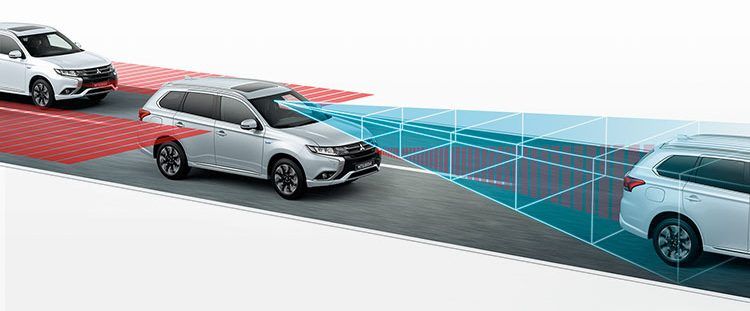
Traffic Jam Assist
Als je op de snelweg bijvoorbeeld 120 km/u rijdt met ingeschakelde ACC en iemand voor je rijdt 100 km/u, dan zal de auto automatisch vertragen, eventueel door actief de remmen te bedienen, en continu de door jouw ingestelde afstand bewaren. Als de voorligger van baan voor je neus verdwijnt of accelereert, zal de auto automatisch versnellen tot de ingestelde snelheid.
Ook bij langzaam rijdend in de file verkeer zorgt de ACC voor extra gemoedsrust en minder stress. De ACC kan de auto zelf volledig tot stilstand brengen indien nodig, als bijvoorbeeld plotseling hard geremd wordt. Ook in dit geval helpt het systeem een kop-staartbotsing te voorkomen of de gevolgen daarvan te verminderen. Als de auto tot stilstand gebracht is, schakelt de ACC zich automatisch uit. Dat geldt echter niet voor Mitsubishi Eclipse Cross . Bij dit model wordt de ACC gecombineerd met Traffic Jam Assist. Dat betekent dat de auto ook weer optrekt om het verkeer te blijven volgen. met deze functie was filerijden nog nooit zo ontspannen.
Gezien het feit dat de ACC met Traffic Jam Assist zelfstandig moet kunnen optrekken vanuit stilstand en tot snelheden boven de 100 km/u moet kunnen accelereren, is deze functie alleen beschikbaar voor de Eclipse Cross met automatische transmissie.
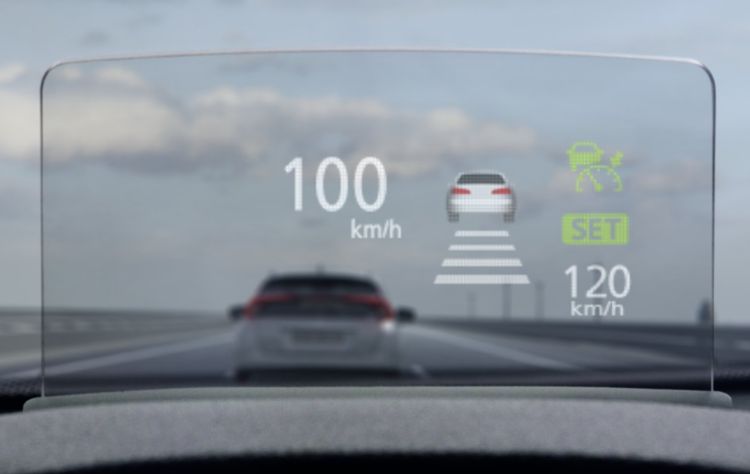
Wist je dat?
Mitsubishi Motors was in 1992 de eerste autofabrikant ter wereld die een ‘afstandswaarschuwingssysteem’ introduceerde. Dit systeem was leverbaar op de Mitsubishi Debonair in Japan en gaf een waarschuwingssignaal bij een te kleine afstand tot de voorligger.
Later, in 1995, was Mitsubishi Motors de eerste die een auto met Preview Distance Control leverde. De Mitsubishi Diamante maakte gebruik van een lasersysteem om de afstand tot de voorligger te meten en kon automatisch gas loslaten en terugschakelen bij een te kleine afstand tot de voorligger.
Deze systemen die in de jaren negentig al geleverd werden, waren in feite de vroege voorvaders van de huidige Adaptive Cruise Control. Het voornaamste verschil is dat de elektronica nu zodanig ver ontwikkeld is, dat de remmen automatisch en met de exact benodigde remkracht bediend kunnen worden, en bovendien met een nauwelijks te evenaren reactiesnelheid.
LEES OOK: Forward Collision Mitigation: wat is het en hoe werkt het?
adaptive cruise control ADAS Mitsubishi Motors Veiligheid
Ook interessant

Wil je op de hoogte blijven?
Schrijf je hier in voor regelmatige ClearTechnology updates!
Wij maken gebruik van cookies.
Wij maken gebruik van cookies om het gebruik van onze website te analyseren en het gebruiksgemak te verbeteren. Als u hiermee akkoord gaat, klik dan op 'Accepteren'. Als u meer wilt weten over cookies en de wijze waarop Mitsubishi Motors informatie verzamelt, klik dan op 'Algemeen Privacy- en Cookiebeleid'.
- Inloggen voor de Zaak
Adaptieve cruisecontrol
Cruise control laat je auto met een constante snelheid rijden. Adaptieve cruisecontrol gaat een stapje verder. Adaptieve cruisecontrol kan ook remmen of gas geven.
Wat doet 'ie?
Rijd je te dicht op je voorganger, minder dan zo’n 2 seconden of 20 meter, dan past de adaptieve cruisecontrol je snelheid automatisch aan. Sommige uitgebreide adaptieve systemen kunnen zelfs filerijden. Deze slimme cruisecontrol is goed voor de verkeersveiligheid en de doorstroming.
Hoe werkt ’ie?
Aan de voorzijde van de auto, bijvoorbeeld in de bumper of binnenspiegel, zit een sensor die meet de afstand tot je voorligger en zijn snelheid. Deze sensor stuurt de informatie naar een computer en vergelijkt die met de ingestelde snelheid en berekent een veilige volgafstand. Moet de snelheid worden aangepast – afremmen of versnellen – dan communiceert de adaptieve cruisecontrol dit met de ABS en motor.
Waardoor slijt ’ie?
De adaptieve cruisecontrol slijt niet, maar de sensor kan wel vuil worden of bij een aanrijding kapotgaan, ook als dat in eerste instantie niet zichtbaar is. In zo’n geval is het verstandig om even langs je garage te rijden.
Meer weten? Stel een vraag aan of zoek een antwoord van onze auto experts
Speciaal voor jou geselecteerd
Het meest complete Private Lease pakket. Nu als aanbieding de nieuwe Kia Picanto.
Met een ANWB Autoverzekering ben je altijd verzekerd van de beste hulp bij een botsing of andere autoschade. Zo kun jij zonder zorgen de weg op.
Huur een auto bij de ANWB in binnen- en buitenland. Tegen aantrekkelijke all-in tarieven. Goed verzekerd en zonder eigen risico!
We doen er alles aan je zo snel mogelijk in eigen auto weer op weg te helpen.
Deel deze pagina
personenauto's
hybride modellen
elektrische modellen
nieuwe modellen
bedrijfswagens
- prijslijsten
- toekomstige modellen
- concept cars
E-Tech electric & hybrid
- E-Tech technologie
- E-Tech 100% electric
- E-Tech full hybrid
- subsidie elektrische auto's
- veelgestelde vragen
- mild hybrid
- verbrandingsmotoren
Onderhoud en service
- onderhoudscontracten
- lease- en zakelijk onderhoud
- terugroepacties
- airconditioning
- werkplaatsafspraak maken
- welkomstcheck plannen
- onderhoud en reparatie
- Renault Advantage
- erkend schadeherstel
- Premium Pas
- accessoires
- onderhoudsprijzen
garantie, verzekering en pechhulp
- autoverzekering
- contact met dealer
- Renault rent
over jouw Renault
- Renault connect: navigatie en multimedia
- instructieboekjes
- autofuncties
- inloggen My Renault
Renault Occasions
- alle occasions
- occasion financieren
- top occasion garantie
- alles over Renault occasions
top occasions
- Renault Clio
- Renault Captur
- Renault Espace
- Renault Grand Scenic
- Renault Kadjar
- Renault Talisman
- Renault Megane
- Renault Scenic
- Renault Zoe
Private lease en financiering
zakelijk leasen & financieren
- financial lease
- operational lease
- elektrische leaseauto
- bedrijfswagens financieren
- Renault lease-onderhoud
Megane E-Tech 100% electric zakelijk leasen

Particulier - leasen & financieren
- private lease
- hoe werkt private lease
- voordelen private lease
- nieuwe auto financieren
- bekijk ons volledig private lease aanbod
- kopen, leasen of financieren?
- bijtelling berekenen
- begrippenlijst
- meer over Mobilize financial services
- contact met Mobilize Financial Services
- algemene voorwaarden
Over Renault
ontdek Renault
- het merk Renault
- groupe Renault
- Renaulution
- duurzaamheid
- Renault Media
- Original Services
wt5 by reno app
onze passie
- iconen van renault
- Safety by Renault
- Renault Sport
- Losange magazine
- 125 jaar Renault
ontdek Renault en Roland Garros

nieuwe ontwikkelingen
- Renault CONNECT
- Renault Blog
- Renault nieuwsbrief
ontdek Renault NFT
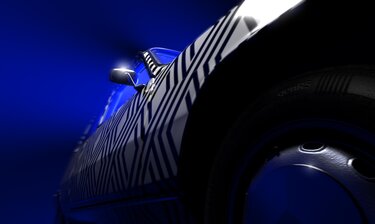
regelgeving
- energielabels voor banden
ons icoon: R5 bestaat 50 jaar.
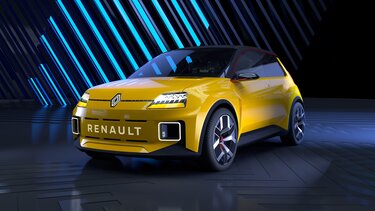
Adaptive Cruise Control (ACC)
Adaptive Cruise Control is een handige en fijne innovatie. Deze rijassistent helpt je veiliger, zuiniger en vooral soepeler door het drukke verkeer heen.
- Wat is Adaptive Cruise Control (ACC)
- Aan- en uitzetten
- Regelgeving
- andere autofuncties
wat is Adaptive Cruise Control (ACC)?
Adaptive Cruise Control (ACC) is een veiligheidssysteem dat de snelheid van de auto automatisch aanpast om een veilige afstand tot je voorligger te bewaren. Kom je te dichtbij? Dan activeren de remmen vanzelf. Er wordt pas weer gas bij gegeven als de afstand groot genoeg is.
Adaptive Cruise Control meet met een geavanceerde radarsensor in de bumper of grill en een hoge resolutie camera in de achteruitkijkspiegel of voorruit de afstand tot de auto die voor je rijdt. Daarbij houdt de auto de door jou ingestelde snelheid. Ook bewaart ACC automatisch een zo gelijk mogelijke afstand tot de voorligger. Moet je toch even ingrijpen als bestuurder? Dan geeft jouw auto dat automatisch en op tijd aan. Adaptive Cruise Control is dus zowel slim, handig als veilig.
waarom is Adaptive Cruise Control belangrijk?
1. comfortabel rijden, 2. veiliger rijden, 3. gelijkmatig rijden.
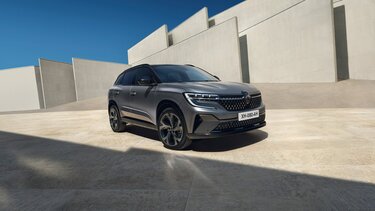
comfortabel rijden
De bestuurder kan comfortabeler rijden en hoeft niet voortdurend zijn voorganger in de gaten te houden.

veiliger rijden
Door gebruik van Adaptive Cruise Control vinden er minder ongelukken plaats en hierdoor wordt het veiliger in het verkeer.
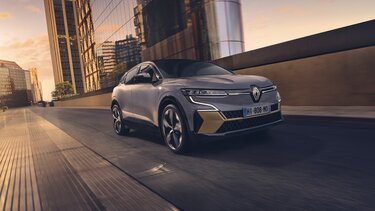
gelijkmatig rijden
De doorstroming van het verkeer op drukke wegen is beter, omdat auto’s door ACC gelijkmatiger rijden.
aan de slag met Adaptive Cruise Control
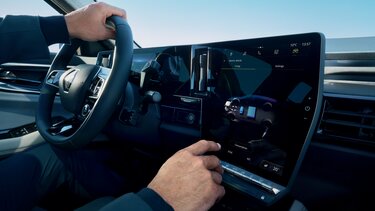
wanneer gebruik je Adaptive Cruise Control wel of niet?
Adaptive Cruise Control (ACC) is in te schakelen bij een snelheid vanaf 50 km/u. Vanaf dat moment werkt ook de automatische afstandsregeling tot de voorganger. Adaptive Cruise Control is vooral handig voor langere ritten op de snelweg.
Fabrikanten raden aan om deze systemen onder bepaalde omstandigheden niet te gebruiken, onder andere in tunnels. In een tunnel kan ACC namelijk onverwachts reageren en voor verrassingen zorgen. Dit komt onder andere door slechte tunnelverlichting en GPS signaalontvangst, maar ook door onverwacht rijgedrag van andere bestuurders.
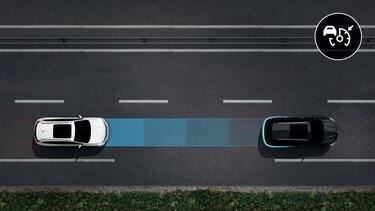
hoe moet je Adaptive Cruise Control aan- of uitzetten?
De Adaptive Cruise Control (ACC) is in te schakelen bij een snelheid vanaf 50 km/u. In de meeste moderne auto's met Adaptive Cruise Control (ACC) is er een mogelijkheid om het systeem uit te schakelen. Wil je exact weten hoe je dit doet? Raadpleeg dan de handleiding van je specifieke auto .

is Adaptive Cruise Control zuinig?
Met behulp van Adaptive Cruise Control rijd je zuiniger dan zonder. Met ACC rijd je namelijk een constante snelheid. Dat betekent minder remmen én minder gas geven. En dit bespaart brandstof. Wanneer je zelf rijdt, is het lastig om de motor een constant toerental te laten draaien.
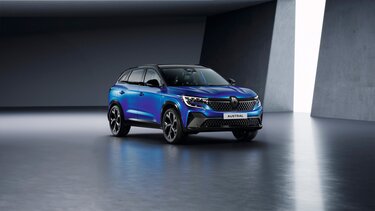
is Adaptive Cruise Control verplicht?
Elk nieuw automodel en autotype heeft vanaf 2022 Adaptive Cruise Control (ACC). Vanaf 2024 verplicht Europa de autoconstructeurs om die functie ook in alle nieuwe auto's te plaatsen. Het slimme systeem is dus absoluut onmisbaar.
meer over andere autofuncties
Renault werkt voortdurend aan innovaties die onze modellen niet alleen comfortabeler maken, maar ook zorgen voor meer veiligheid op de weg. Benieuwd welke andere autofuncties er zijn en hoe deze werken? Ontdek dan snel alle autofuncties in Renault auto’s .
my Renault word gratis lid van My Renault
rijd langs! meer dan 150 dealers
volg ons! @Renault_NL
nieuwsbrief meld je aan!
Demystifying Adaptive Cruise Control: A Comprehensive Guide
As an auto tech expert and self-driving car enthusiast, I often get asked about Adaptive Cruise Control (ACC) and how exactly it works to automatically adjust your car‘s speed. ACC is one of the coolest semi-autonomous technologies available today, making highway drives safer and less stressful. But it‘s also complex under the hood!
In this comprehensive guide, I‘ll give you an in-depth look at ACC – how it works, different types, key benefits, limitations, and what the future holds for adaptive cruise and autonomous driving.
ACC 101 – Adjusting Speed to the Car in Front
ACC uses radar, laser sensors or cameras to monitor the vehicle ahead and adjust your speed accordingly to maintain a preset following distance. If the vehicle in front slows, so does your car – automatically! ACC reduces the constant manual braking and acceleration required in heavy traffic.
Here‘s a quick ACC capability comparison:
ACC delivers a major safety and convenience upgrade from old cruise control technology first introduced in the 1950s. Let‘s look under the hood at how ACC performs this speed adaptation trickery…
ACC Sensor Technology – Radar vs. Laser vs. Camera
ACC systems rely on forward-facing sensors to detect the speed and distance of vehicles ahead. Most ACC systems use radar (radio waves), while some premium vehicles use laser sensors or cameras paired with image processing. Here‘s how each sensor approach works:
Radar Adaptive Cruise Control
- Uses radio waves in the 24 GHz or 77 GHz frequency bands
- Excellent range (160m+) and unaffected by weather
- Distributed beam provides wide field of view
- Cannot identify shape and classification of objects
- Overall the most robust and widely adopted ACC technology
Laser Adaptive Cruise Control
- LIDAR (Light Detection and Ranging) laser sensors
- Very high resolution and accuracy
- Narrow, focused beam with longer range than radar
- Performance impacted by weather and dirt
- Limited adoption due to higher cost
Camera-Based Adaptive Cruise Control
- Uses front-facing camera and video processing
- Can visually identify vehicles braking ahead
- Shorter effective range with narrow field of view
- Limited use for ACC, better for lane centering
Radar ACC is the most common since it combines long range, wide scanning angle, with reasonable cost. However, some automakers like Toyota and BMW use both radar and cameras to complement each other.
Real World ACC Performance
In optimal highway conditions, ACC works exceptionally well to adapt your vehicle‘s speed based on traffic ahead. However, ACC has limitations that require driver supervision:
Following distance – Most systems allow setting 1,2 or 3 second gap to car ahead. Younger drivers tend to prefer the risky 1 second gap!
Cut-ins – When a vehicle changes lane in front, ACC response can be delayed
Curves & hills – Around blind turns or over hills, performance drops as radar line-of-sight is lost
Bad weather – Heavy rain, snow, and fog degrade radar and laser sensor effectiveness
Bright light – Low sun angles and bright reflections can overwhelm camera sensors
Small objects – Most ACC systems have trouble consistently detecting motorcycles, bicycles, pedestrians
While ACC has its limits, it‘s remarkably helpful day-to-day in reducing driver burden. But expect some occasionally quirky behavior so you‘re not caught off guard!
ACC Availability Across Vehicle Makes
ACC technology premiered in 1992, but only became popular on luxury cars in the early 2000s. ACC is now commonplace across all major auto brands:
And it‘s a standard feature on most luxury vehicles:
With so many automakers offering ACC, it‘s now an expected convenience feature for car buyers.
Comparing OEM Adaptive Cruise Systems
While ACC capabilities are similar across brands, there are some notable differences between automaker systems:
Mercedes-Benz Distronic
- Industry-leading ACC technology since introduced in 1998
- Uses long-range 77 GHz radar + stereo cameras
- Capable of full stop-and-go operation
- Automatically adjusts speed for curves and junctions
GM Super Cruise
- Camera + radar ACC combined with precision GPS mapping
- Enables hands-free driving on limited access highways
- Driver attention monitoring via face tracking camera
Nissan ProPilot Assist
- Budget ACC + lane centering system
- Smooth performance but more limited capability
- Delayed responses compared to premium systems
Toyota Dynamic Radar Cruise
- Lower speed operation down to 25mph
- Conservative speed adjustment when following
- Prone to leaving large gaps in traffic
Overall Mercedes sets the benchmark for ACC performance and capability in my opinion, with German automakers continuing to lead the way.
Adding ACC to Older Vehicles
You don‘t need to buy a new car to experience ACC convenience. There are aftermarket ACC systems available to add radar-based speed adaptation to older vehicles:
Comma Two : $1100 standalone ACC system powered by camera and radar sensors. Installs by connecting directly to vehicle CAN bus. Impressive capabilities given aftermarket nature.
Autocruise : $2500 ACC system requiring professional installation. Uses front camera and radar sensors. Provides ACC + lane centering.
RoadMate : $1800 radar-only ACC system. Easier self-install with OBDII plug-in. But limited braking capability.
Aftermarket systems provide a taste of ACC and advanced driver assist capabilities. But overall, OEM automaker ACC integration delivers a smoother and more reliable driver experience.
The Road to Fully Autonomous Driving
A key benefit of ACC systems is paving the way for fully autonomous self-driving vehicle (SDV) technology. The cruise control computers, radars, and cameras ACC relies on provide the foundational sensing and actuation building blocks for SDVs.
Here are some of the key ACC enhancements feeding into full autonomy:
Improved camera imaging – Higher resolution, HDR, night vision, wider field of view
Sensor fusion – Combining radar, camera and ultrasounds for 360 degree coverage
Tighter vehicle integration – Braking and steering authority expanded beyond ACC
Detailed 3D mapping – Ultra-precise maps enable self-driving without relying solely on sensors
V2X communication – Sharing intent and sensor data with nearby vehicles, infrastructure
Redundant systems – Backup sensors, computers, and actuators to maximize safety
The big challenge is mastering full self-driving in complex urban environments. While ACC handles long boring highway drives, crowded city streets require an entirely new level of autonomous driving expertise.
Optimizing ACC for the Future
As an auto tech expert, I see great potential ahead for ACC technology. But there are also improvements I‘d love to see:
Quicker reactions – Faster stopping when vehicle cuts in front
All speed operation – ACC availability even in start-stop traffic
Improved object detection – Identifying pedestrians, cyclists, animals
Left/right radar – Side-facing sensors to monitor blind spots
Personalization – Driver tailored ACC preferences and profiles
Intuitive controls – Simplifying overly complex ACC settings menus
Seamless transitions – Handoff between ACC, lane centering and parking systems
Driver monitoring – Alerts for distraction and loss of attention
With future refinement, ACC can move beyond just being a convenience feature and provide truly safe semi-autonomous driving.
Challenges Facing Consumer ACC Adoption
Despite the benefits of ACC, there are still barriers to mass consumer adoption:
Cost – Only available on higher trim models outside budget for many car buyers
Trust – Drivers underestimate capabilities and effectiveness of ACC
Complexity – Many settings overwhelm drivers new to the technology
Reliability – Sensor degradation and performance concerns over vehicle lifetime
Education – Lack of ACC training for consumers
Addressing these challenges will be key for ACC to transition from a luxury feature to a standard capability that drivers actually use day-to-day.
Testing and Validating Adaptive Cruise Systems
Before ACC systems hit the road, automakers put them through rigorous testing to ensure safety:
Hardware-in-the-Loop – Validating ACC sensor + ECU integration
Test track assessment – Repeated runs observing ACC capability in action
Scenario testing – Emulating cut-ins, curved roads, weather effects
Naturalistic driving – Recording ACC use in real uncontrolled driving
Simulation – Modeling ACC components and logic virtually
Public road testing – Validation in early prototype vehicles
Safety audits – Third-party review of ACC functionality
Months of testing provides confidence in ACC operation. But it‘s impossible to evaluate every edge case scenario an ACC system may encounter once on the road.
Insider ACC Troubleshooting Tips
To dig deeper into ACC, I connected with Sam who works on ACC radar sensor calibration at General Motors. He shared some pro tips on troubleshooting ACC issues:
"One problem we see is radar misalignment that prevents ACC from detecting vehicles ahead accurately. This can occur if the radar or front bumper gets even slightly shifted, say due to a minor collision. I recommend first visually inspecting the radar position and realigning if necessary. Also watch out for mud or snow buildup around the sensor which can block radio waves."
"Software bugs are another ACC gremlin, like incorrect gap distance or delayed braking. But these can often be remedied with an ECU update at the dealership. And make sure the windshield in front of the camera is squeaky clean for camera-based systems! Dirty glass is an easy pitfall."
So when ACC acts up, check for sensor obstructions, misalignment, and also ask your dealer to verify the latest software is installed.
I hope this ACC deep dive has helped shed light on how this clever technology works and what the future holds. Let me know if you have any other ACC questions!
How useful was this post?
Click on a star to rate it!
Average rating 0 / 5. Vote count: 0
No votes so far! Be the first to rate this post.
Share this:
You may like to read,.
- Why is $2 Good Luck? Digging into the Quirky History and Lore of the $2 Bill
- How Do I Switch to NA Servers? The Ultimate Guide for Ping Lovers
- What Does it Mean When a Symbiote is Red?
- Hey friend, let‘s settle this – are Rabbids good or evil?
- Why is stealing a car called Grand Theft Auto?
- Using USB SuperSpeed for Monitor Connectivity – An In-Depth Guide
- Is 4GB RAM 64GB Good Enough in 2024?
- What is an Omega Slick? The Complete Expert Guide

- GTA 5 Cheats
- Print on a Chromebook
- Nothing Phone 2 Review
- Best YouTube TV Alternatives
- Asus ROG Ally vs. Steam Deck
- Gameshare on Nintendo Switch
What is adaptive cruise control?
It’s not a stretch to call cruise control one of the earliest driving aids. It wasn’t always electronic, and it certainly didn’t make your grandfather’s 1982 Cadillac Seville autonomous, but it was a revolutionary invention. (Although here’s a fun fact: Your grandfather’s Buick had the first infotainment system way back in 1986.)
What to look for in an adaptive cruise control system
What do automakers call adaptive cruise control, are there aftermarket adaptive cruise control systems, who does adaptive cruise control best.
Adaptive cruise control takes it to the next level. It maintains a set speed for your vehicle, like a conventional cruise control system, but it also adjusts the speed based on the traffic flow. Better systems can come you a full stop in heavy traffic and continue when congestion lightens. This technology can make cruise control more useful by taking some (but not all) of the workload off the driver. Here’s what it is, and how it works.
The concept is simple: Make the car accelerates and decelerates automatically depending on how quickly the cars around it are moving. The devil’s in the details, however.
- GM to cut funding for beleaguered driverless startup Cruise, report claims
- Cruise woes prompt production halt of fully driverless van
- Cruise autonomous vehicle drives over woman just after she was hit by another car
To do it, a car must be equipped with sensors that allow it to detect nearby vehicles and potential obstacles. Most adaptive cruise control systems use radar, with high resolution radar on the horizon, although a camera and lidar (which works on the same principle as radar, but with light waves) can be used as well. You can often spot these cameras integrated into the grille or mounted behind the windshield. These sensors communicate with a computer that controls the throttle and, sometimes, the brakes and the steering system.
In its most basic form, adaptive cruise control technology only handles acceleration and deceleration, usually by following the car in front and maintaining a set following distance. Some automakers have started bundling this feature with a system that can bring the car to a full stop if needed, which comes in handy in a traffic jam, and/or one that provides a limited amount of steering assistance to keep the car centered in its lane.
Adaptive cruise control is at the center of the pile of electronic driving aids some automakers believe could form the basis of fully autonomous driving . We’re nowhere near autonomous cars, though, and it’s important not to mistake adaptive cruise control and other related technologies for full autonomy. These systems are designed to help the driver, not to drive the car themselves while the driver dozes off or counts blue cars going the other way.
Adaptive cruise control is sometimes known as dynamic radar cruise control or intelligent cruise control, and most automakers give the system brand names to make it more marketable. Regardless, the basic idea is that a car accelerates and decelerates automatically depending on how quickly the cars around it are moving.
BMW: Active Cruise Control, Active Cruise Control with Stop and Go Cadillac: Super Cruise Honda and Acura: Adaptive Cruise Control, Adaptive Cruise Control with Low-Speed Follow Hyundai: Smart Cruise Control Kia: Advanced Smart Cruise Control Mercedes-Benz: Active Distance Assist Distronic Nissan and Infiniti: Intelligent Cruise Control, a part of Nissan’s ProPilot 2.0 system Subaru: Adaptive Cruise Control, Adaptive Cruise Control with Lane Centering, part of the brand’s EyeSight package Tesla: Autopilot Toyota and Lexus : Dynamic Cruise Control, Dynamic Cruise Control with Stop and Go
This is one technology that cannot easily be retrofitted to an existing car. The complexity of adaptive cruise control systems puts them beyond the reach of the aftermarket. Considering that these systems can mean the difference between a car driving along and a car smashing into the back of another vehicle, concerns over liability will probably keep adaptive cruise control firmly within the domain of the original equipment manufacturers for the time being.
Like systems available from other automakers, Cadillac’s Super Cruise allows the car to accelerate, steer, and brake without driver intervention on highways. But Cadillac is the only automaker to specifically claim that drivers can take their hands off the wheel. That’s because Cadillac did a thorough job in setting up Super Cruise. Not only does the system rely on an array of cameras, radar, and lidar, but Cadillac also mapped 200,000 miles of highway. Super Cruise also has a driver-facing camera, and will only work if a certain level of driver alertness is maintained.
It’s too bad Super Cruise isn’t widely available, at least, not yet. Cadillac launched the system on its flagship CT6 sedan but has been slow to expand to other models. With the CT6 set to be discontinued, Cadillac finally announced that Super Cruise will be available on the CT4 and CT5 sedans when they go on sale in the coming months. Those sedans use a new electrical architecture that can support Super Cruise.
Subaru’s EyeSight system uses cameras instead of radar, bringing down its cost and making installation of the hardware a bit easier. EyeSight bundles adaptive cruise control with lane-keeping assist, a “pre-collision throttle management” feature that cuts the throttle ahead of an anticipated collision, and low-speed autonomous emergency braking. On some models, Subaru has also added a driver-facing camera to ensure the driver stays alert while these features are in use.
Mercedes-Benz
Mercedes offers one of the most comprehensive adaptive cruise control and driver-assistance suites of any automaker. Its latest Distronic Plus system can keep up with traffic, but also brake the car to a full stop in stop-and-go situations. The system will automatically resume driving if the car remains stopped for less than three seconds; longer stops require a tap of the accelerator pedal or of the cruise control’s “resume” button. A steering-assist feature helps keep the car centered in its lane, and certain versions of the system can initiate lane changes.
Tesla’s Autopilot system has attracted its share of controversy, and the name is a bit misleading considering that a human driver must be kept in the loop, but it’s still one of the most advanced systems of its kind. In addition to following traffic and automatically keeping a car in its lane, Autopilot can execute lane changes with the flick of a turn signal, and negotiate some highway off-ramps. Tesla’s ability to pull data from cars using the system and launch over-the-air software updates means Autopilot has significant potential to improve over time.
It’s no surprise that an automaker obsessed with safety was an early adopter of adaptive cruise control. Volvo was also one of the first automakers to pair the technology with autonomous emergency braking, allowing a car to both automatically follow a vehicle in front and brake if it encounters an obstacle. Volvo’s latest Pilot Assist II system doesn’t need to track a vehicle ahead, can a keep a car centered in its lane, and can operate at speeds up to 80 mph.
Editors' Recommendations
- Beleaguered robotaxi startup Cruise lays off quarter of workforce
- Cruise woes continue as key figures quit the robotaxi firm
- Cruise’s robotaxi service suspended by California regulator
- Cruise says it’s nearing approval for mass production of futuristic robotaxi
- Robotaxi firm Cruise ordered to halve fleet following incidents

General Motors-backed Cruise revealed this week that its fully driverless cars have now traveled more than a million miles, mostly on the streets of San Francisco.
The achievement comes just 15 months after the company’s first fully driverless ride, during which time it also launched San Francisco’s first paid driverless robotaxi service.
Cruise’s autonomous cars are heading to Texas and Arizona before the end of this year.
The General Motors-owned company plans to launch ridesharing pilots in Austin and Phoenix in what will be its first expansion of the service outside of San Francisco.
General Motors autonomous car unit, Cruise, has started to offer driverless rides to residents of San Francisco as it moves toward the launch of a full-fledged robo-taxi service.
Following a test run of the service last week, Cruise has released a video (below) showing the reaction of the very first passengers as they rode through the streets of the Californian city in a vehicle that had nobody behind the wheel.
Popular Searches
SUBARU STARLINK In-Vehicle Technology
Eyesight Driver Assist Technology
Parts and Accessories
Helpful Links
Customer Service
Vehicle Recalls
All Vehicles
Special Offers
Local Inventory
Our Company
Meet the Subaru Family
What is adaptive cruise control (acc).
Adaptive Cruise Control (ACC) is an intelligent driver assistance feature that works as an enhancement to traditional cruise control. Using a system of advanced sensors such as radar and cameras, ACC determines the speed and conditions of surrounding traffic and automatically adjusts cruising speed to maintain a safe distance within the flow of traffic. Many ACC systems can also recognize sudden changes in traffic conditions and alert the driver to take action to prevent a crash.
Depending on vehicle manufacturer and the system itself, any number of other terms might be used interchangeably with Adaptive Cruise Control, including:
- Active Cruise Control
- Dynamic Cruise Control
- Automatic Cruise Control
- Intelligent Cruise Control
- Smart Cruise Control
- Radar Cruise Control
How does Adaptive Cruise Control Work?
ACC uses a set of intelligent sensors including radar, lidar, lasers, GPS, and cameras. These sensors are placed around a vehicle’s exterior to monitor the road and nearby vehicles. Gathering real-time data on the distance away and speed of the vehicle in front, these sensors allow the ACC system to adjust the car’s speed as-needed. Typically, the driver sets their desired cruising speed when they engage ACC on the highway. The system then automatically accelerates and decelerates to stay at a safe distance from other cars within the flow of traffic.
Much like using traditional cruise control, activating ACC is intentionally simple so that a driver can easily use it while keeping their eyes safely on the road. Generally, the dedicated ACC button or switch is located on the steering wheel or control panel. Pressing or toggling this mechanism allows the driver to set their initial cruising speed. In some systems, drivers can also set their desired following distance.
While operating, certain ACC systems can take extra measures for safety and convenience purposes:
- Maintaining a particular distance from vehicles ahead
- Making complete stops in traffic and restarting from a complete stop when traffic resumes
- Remaining engaged at low speeds in city traffic
- Anticipating and automatically slowing around upcoming curves
- Adjusting to posted speed limits as they change
Once in operation, the ACC system remains working until the driver disengages by either pressing the brake pedal or manually deactivating the system using the dedicated switch or button. Sometimes, ACC will use visual and audio cues to alert the driver to brake if it detects a possible collision ahead. In these instances, the driver must then re-engage the system once traffic resumes.
Benefits of Adaptive Cruise Control
Some of the benefits of adaptive cruise control include creating a more relaxed driving experience, particularly during long road trips and on highways, thanks to the system’s ability to adjust automatically to traffic speed variations and road conditions. Additionally, ACC encourages safe driving practices and helps reduce crash risk by monitoring following distance and alerting the driver or intervening if a vehicle is quickly approaching. Drivers using ACC may also see improved fuel efficiency, especially on the highway, since the system helps maintain an even speed and reduces unnecessary acceleration and braking.
Advanced Adaptive Cruise Control in Subaru Vehicles
The Subaru application of ACC is known as Advanced Adaptive Cruise Control. This feature functions seamlessly as part of our EyeSight ® Driver Assist technology —a comprehensive suite of safety features designed to enhance the driving experience. Nearly all Subaru models and trims come standard with EyeSight and Advanced Adaptive Cruise Control, including some of our most popular models like the Outback , Forester , Crosstrek , and Impreza . EyeSight is an available feature on our performance sports models with automatic transmissions, including the WRX and the BRZ , as well as those with manual transmissions.
Complementing its active cruise control functionality, EyeSight includes additional advanced features including Pre-Collision Braking and Throttle Management, Automatic Emergency Steering, Lane Centering, and Lane Departure Assist designed to help keep drivers safer. In particular, Lane Departure Assist and Lane Centering monitor lane markings and can help assist drivers with steering to avoid accidental drifting into another lane. The advanced ACC sensors can also recognize another driver approaching and adjust your vehicle’s placement within the lane to create a safer distance on all sides.
Read more about our EyeSight technology.
Discover the Safety and Convenience of Subaru EyeSight Driver Assist Technology. Visit Us to Experience it in Action and Find your Perfect Subaru Today!
Advanced adaptive cruise control is a useful feature that can help make driving easier, smoother, and safer. Explore Subaru Vehicles equipped with the full suite of EyeSight features today!
Explore Subaru
Our vehicles will inspire drivers like you to become a Subaru owner for life. Find out what makes us more than a car company.
Connect with Us
About Subaru
Other Subaru Sites
© Subaru of America, Inc. Use of this site signifies your acceptance of the Terms & Conditions .
- Privacy Policies
- California Privacy
- Cookie and Ad Preferences
* MSRP does not include destination and delivery charges, tax, title, and registration fees. Destination and delivery includes handling and inland freight fees and may vary in some states. Prices, specifications, options, features, and models subject to change without notice. Select colors may be subject to an additional charge. See your retailer for more information.
** EPA-estimated fuel economy. Actual mileage may vary. For Crosstrek Hybrid and Solterra, EPA-estimated MPG equivalent on a full battery charge. Actual mileage will vary.
*** Limited warranties are contingent on age and mileage. Whatever comes first concludes the warranty.
† Connected Services depend on factors outside Toyota's control, including an operative telematics device, a cellular connection, GPS signal and the availability of a compatible wireless network, without which system functionality and availability may be limited or precluded, including access to response center and emergency support. Service may vary by vehicle and region. Apps and services subject to change at any time without notice. Requires app download/registration and subscription after trial (if applicable). Terms of Use apply. Data usage and charges may apply. To learn about Toyota’s connected services data collection, use, sharing and retention practices, please visit toyota.com/privacyvts
Safety Connect: Stolen vehicle police report required to use Stolen Vehicle Locator. Automatic Collision Notification activates only in limited circumstances.
Remote Connect: Use only if aware of circumstances surrounding vehicle and it is legal and safe to do so (e.g., do not remotely start engine if vehicle is in an enclosed space or vehicle is occupied by a child). Remote start/stop not available on manual transmission-equipped vehicles.
Drive Connect: Services not available in every city or roadway.
Service Connect: Information provided is based on the last time data was collected from the vehicle and is not real time data. Service Connect is not renewable as a stand-alone service and requires a subscription to any of Safety Connect, Remote Connect or Drive Connect upon trial expiration.
Wi-Fi Connect: Eligible vehicle and wireless service required. Wi-Fi Connect coverage and service not available everywhere. Valid in the contiguous U.S. and Alaska. Do not drive distracted. Go to att.com/solterra for terms and conditions. Up to 5 devices can be supported using in-vehicle connectivity. The Wi-Fi Connect trial begins at the time of enrollment activation and expires when 30 days or the earlier of 3GB of data is used or the 1-month period ends. Subscription required after trial. Integrated Streaming requires subscription for third-party provider services.
Subaru has the utmost respect for the environment and is a proud partner of Leave No Trace. Care was taken not to harm the environment when taking this photo.
The materials displayed on this website, including but not limited to all text, audio, video, images, photographs, illustrations, artwork, animation files and other graphics, names, logos, trademarks, and service marks, are property of Subaru or its parent or affiliated companies or its licensors and are protected by copyright, trademark, and other intellectual property laws. This site may be displayed, downloaded, and/or printed solely for your personal, non-commercial home use, provided that you do not delete or modify any copyright, trademark, or other proprietary notices. Any other use of the material on this site without the prior written consent of Subaru is strictly prohibited.
iPod and iPad are registered trademarks of Apple Inc.; Brembo is a registered trademark of Freni Brembo S.p.A.; Alcantara is a registered trademark of Alcantara S.p.A and Alcantara is produced by Toray Group.; Ultrasuede® is a registered trademark of Toray Industries, Inc.; TORSEN LSD® is a registered trademark of JTEKT TORSEN North America, Inc BBS is a registered trademark of BBS Kraftfahrzeugtechnik AG.; Bluetooth is a registered trademark of Bluetooth SIG, Inc.; HomeLink® and the HomeLink® house icon are registered trademarks of Gentex Corporation.; Tom Tom is a registered trademark of TomTom International BV; Aha and Harman Kardon are a registered trademarks of Harman International Industries, Inc.; Android is a trademark of Google Inc.; HD Radio is a registered trademark of iBiquity Digital Corporation.; SiriusXM and SiriusXM NavTraffic are registered trademarks of SiriusXM Satellite Radio, Inc.; iHeart is a registered trademark of Clear Channel.
PLEASE REVIEW THESE IMPORTANT DISCLOSURES.
Subaru of America, Inc. reserves the right to make changes at any time without notice or obligation to the information contained on this Internet site, prices, incentive programs, specifications, equipment, colors, materials, product illustrations and to change or discontinue models. All prices are based upon Manufacturer's Suggested Retail Prices ('MSRP') in U.S. dollars (unless otherwise indicated) and exclude taxes, title fees, licensing, options and destination charges unless specifically included. Retailers are independent businesses and are free to set their own retail prices. All information contained at this Internet site is intended for the USA market only.
** EPA-estimated fuel economy. Actual mileage may vary. For Crosstrek Hybrid and Solterra, EPA-estimated MPG equivalent on a full battery charge. Actual mileage will vary.
- What's My Car Worth?
- Buyer's Guide
Cars with Adaptive Cruise Control: Everything You Need to Know
Cars with adaptive cruise control used to be considered a luxury only featured in state-of-the-art vehicles. Still, with technological advancements, adaptive cruise control is now a common feature found in many different car models.
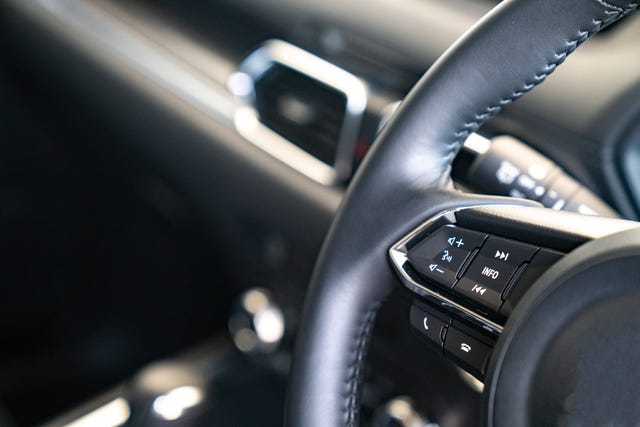
Cars with adaptive cruise control used to be considered a luxury only featured in state-of-the-art vehicles. Still, with technological advancements, adaptive cruise control is now a common feature found in many different car models. Autobytel says this means ACC is now accessible to everyone, and even if your current vehicle doesn't have ACC, you can always have it installed.
What Does Adaptive Cruise Control Do?
Adaptive cruise control uses advanced sensory technology to determine your car's speed in proximity to other vehicles or objects on or around the roadway. It applies moderate brakes and warning signals when a driver is getting to close to another car. Drivers can set the speed limit on the ACC so that they don't exceed the speed limit, but when the sensory technology detects traffic or other unsafe conditions, it reduces the driver's speed to adapt to them.
The Best Cars With Adaptive Cruise Control
1. 2020 bmw 3 series.
This brand new model offers the best combination of sensory technology . It uses cameras in addition to ultrasonic and radar sensors to pull data about the environment surrounding the vehicle. In addition to its sensory features, it also has a "stop-and-go" brake feature, great for commuters who spend extended amounts of time in stand-still traffic as it alleviates the stress on the driver's legs and feet. What's more, the camera sensor can pick up traffic signs such as speed limit signs and reduce or increase speed to match the recommended rate of speed.
2. 2020 Volvo S60
This new model by Volvo has a "Pilot Assist" feature, which makes driving safe and easy. What this feature does is it helps the driver maintain the proper speed with neighboring vehicles, and it also provides steering assistance along with automatic braking or accelerating for situations such as stop-and-go to free-flowing traffic. Another great aspect of this model is that it doesn't rely on a lead car to determine speed and spacing, so you can use it even when you aren't near another car.
3. 2020 Hyundai Sonata
This new Hyundai model has the same technological systems as other Hyundai models, called "SmartSense advanced driving assistance systems." The 2020 Hyundai Sonata includes SmartSense features such as five cameras, three radar sensors, and 12 ultrasonic sensors to help with things such as advanced cruise control, stop-and-go feature, warning signals, and automatic braking or accelerating.
4. 2020 Nissan Altima
The 2020 Nissan Altima features Nissan's "ProPilot Assist" system, which uses advanced technology to help drivers practice safe driving. It allows drivers with automatic acceleration and braking for speed and distance control, while it also uses automatic steering to help them maintain lane control. These helpful features are made possible by its front-facing cameras, sensors, radar, and electronic control module.
5. 2020 Toyota Corolla Hatchback
This new model provides drivers with an adaptive cruise control system, specifically designed for highway travel. Its cruise control features include cameras within the car and radar sensors on the front grille that can gauge your car's proximity and speed when compared to other vehicles around you. Similarly, these sensors help determine the rate of speed of the vehicle in front of you and automatically decrease your speed if the vehicle in front of you slows down.
The Cheapest Cars With Adaptive Cruise Control
According to U.S.News, here are some examples of the cheapest cars you can buy that still have adaptive cruise control features:
1. 2019 Kia Soul
You can get Kia's "smart cruise control" feature as part of their "Primo Package." This add-on is around $4,500 in addition to the original selling-price. You can save energy with its automatic braking system, and also keep a safe following distance thanks to its forward-collision warning feature. In addition to these safety features, the Kia Soul also provides drivers with a heated steering wheel, and in-depth seat adjustments to meet more complex needs for your body type.
2. 2018 Mazda 3
The 2018 Mazda 3 provides drivers with an adaptive cruise control system that detects rear-cross traffic and blind-spot monitoring, great for making safe lane changes. It also offers a "premium equipment package" for just $1,600 in addition to the original selling price. This package gives your vehicle advanced safety features and other add-ons such as a heated steering wheel and a built-in navigation system.
3. 2018 Hyundai Sonata
The 2018 Hyundai Sonata offers buyers the "technology package" for just $1,000. Included in this package are adaptive cruise control to help drivers maintain a safe following distance and adequate speed. This model also comes with a turbocharged four-cylinder engine.

4. 2018 Toyota Rav4
This 2018 Toyota Rav4 SUV includes an adaptive cruise control system for a fee that increases the original selling price to just above $25,000. When you turn your ACC feature on, it uses its radar sensors to administer collision warnings, automatic braking, and acceleration to make sure that your vehicle moves at a safe pace and maintains an appropriate following distance from other vehicles on the roadway at all times.
The 2018 Toyota Rav4's adaptive cruise control system is categorized as "standard equipment" in Toyota's "Safety Sense P suite of technology," Making it a high-tech safety vehicle for a reasonable price point.
5. 2018 Honda Accord
The 2018 Honda Accord features a state-of-the-art adaptive cruise control system called the "Honda Sensing System." This system offers not only adaptive cruise control but also several other useful safety features, including automatic braking for collision prevention and traffic sign recognition.
These features are powered by camera sensing technology that can read traffic signs such as speed limit markers and adjust the Accord's speed to fit those speed requirements. You can get even more safety features by upgrading to higher-trims.
As adaptive cruise control becomes more readily available, you can find cheap and affordable car models that include much of the same technology as modern luxury cars.
https://www.autobytel.com/car-buying-guides/features/10-cars-with-adaptive-cruise-control-131148/
https://cars.usnews.com/cars-trucks/cheapest-cars-with-adaptive-cruise-control
https://www.caranddriver.com/bmw
https://www.caranddriver.com/shopping-advice/
.css-1updq97:before{background-color:#000000;color:#fff;left:0;width:50%;border:0 solid transparent;bottom:48%;height:0.125rem;content:'';position:absolute;z-index:-2000000;} Research .css-1e2ieb7:after{background-color:#000000;color:#fff;right:0;width:50%;border:0 solid transparent;bottom:48%;height:0.125rem;content:'';position:absolute;z-index:-2000000;}

Tundra vs. Tacoma: Comparing Toyota Pickup Trucks

Honda HR-V vs. CR-V: Examining the Differences
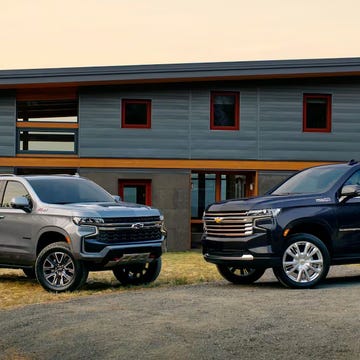
Chevy Tahoe vs. Suburban: Here Are the Differences
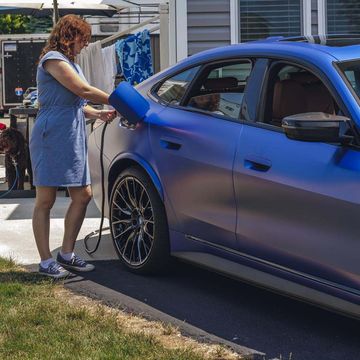
What Are the Different EV Charging Levels?
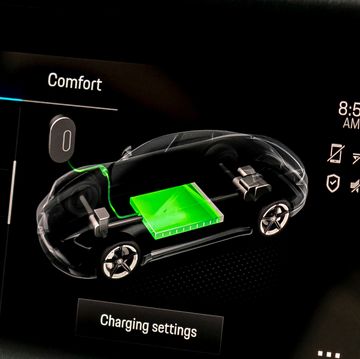
Electric Car Battery Life
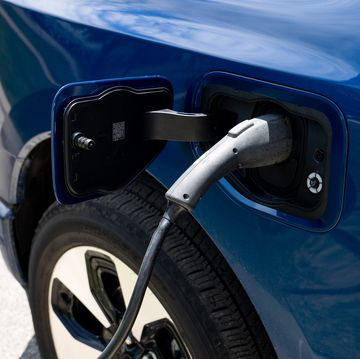
Electric Cars vs. Gas Cars: Pros and Cons

How to Clean Leather Car Seats
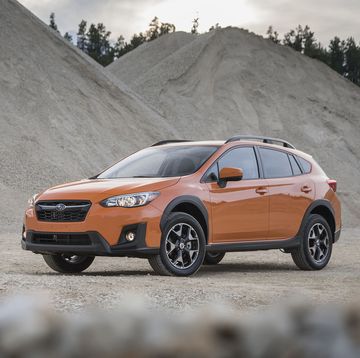
What to Buy: Subaru Crosstrek or Subaru Forester?

What to Buy: Jeep Cherokee or Jeep Grand Cherokee?
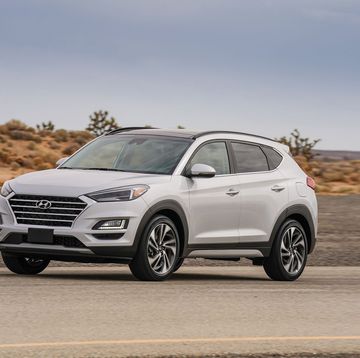
What to Buy: Hyundai Tucson or Hyundai Santa Fe?
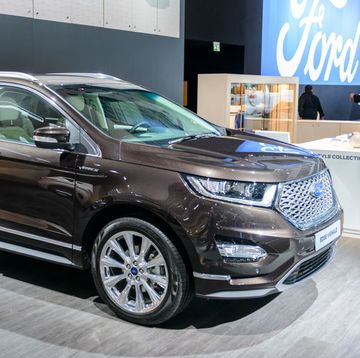
2019 and 2020 Ford Edge Colors
Customer Viewpoint Ratings and Reviews
Who leaves ratings and reviews?
Ratings and reviews are provided by customers who have either purchased a vehicle or visited a dealership for service.
How are ratings and reviews collected?
Customers are invited to participate in a survey administered by MaritzCX, an independent, third-party supplier.
Can dealerships edit or remove reviews?
No. Ford personnel and/or dealership personnel cannot modify or remove reviews.
Are reviews modified or monitored before being published?
MaritzCX moderates public reviews to ensure they contain content that meet Review guidelines, such as:
‣No Profanity or inappropriate defamatory remarks
‣No Personal Identifying information (e.g., customer phone number or email)
‣No Competitor references (e.g., another brand or dealership)
‣Dangerous behavior (e.g. threatening to harm employees or others)
‣Lack of adequate text (e.g., symbols, emoji’s and random letters)
Reviews on the product and not the customer’s Sales or Service experience
- Electric Vehicles
- Pay my bill
- Update my SYNC
- Replace a Part
How do I use Ford Intelligent Adaptive Cruise Control * ?
Watch the video and follow the steps below to learn how to use Intelligent Adaptive Cruise Control, which combines Speed Sign Recognition with Adaptive Cruise Control , to adjust the cruise set speed to the speed limit detected by the speed sign recognition system. For example, if the Speed Sign Recognition system detects a 50 mph speed limit, the cruise set speed is updated to 50 mph.
Using Intelligent Adaptive Cruise Control
Additional information.
What is Speed Sign Recognition? What is Adaptive Cruise Control? What is Lane Centering? What is Auto Hold?
* Feature is available on select vehicles. Features may vary based on model year, trim, options, packages, and supply availability. Use the Build and Price tool to view feature availability on current models. If you have questions or need more information, reference your Owner’s Manual or contact your Ford Dealer . Driver-assist features are supplemental and do not replace the driver’s attention, judgment, and need to control the vehicle. Refer to your Owner’s Manual for details and limitations.
** Don’t drive while distracted or while using handheld devices. Use voice-operated systems when possible. Some features may be locked out while the vehicle is in gear. Not all features are compatible with all phones.
*** Actual screens may vary. See your Owner’s Manual for information specific to your vehicle.

- Victor Mukhin

Victor M. Mukhin was born in 1946 in the town of Orsk, Russia. In 1970 he graduated the Technological Institute in Leningrad. Victor M. Mukhin was directed to work to the scientific-industrial organization "Neorganika" (Elektrostal, Moscow region) where he is working during 47 years, at present as the head of the laboratory of carbon sorbents. Victor M. Mukhin defended a Ph. D. thesis and a doctoral thesis at the Mendeleev University of Chemical Technology of Russia (in 1979 and 1997 accordingly). Professor of Mendeleev University of Chemical Technology of Russia. Scientific interests: production, investigation and application of active carbons, technological and ecological carbon-adsorptive processes, environmental protection, production of ecologically clean food.
Title : Active carbons as nanoporous materials for solving of environmental problems
Quick links.
- Conference Brochure
- Tentative Program


Turn Your Curiosity Into Discovery
Latest facts.
12 Facts About Beer Pong Day May 4th
15 Facts About National Gummi Bear Day April 27th
40 facts about elektrostal.
Written by Lanette Mayes
Modified & Updated: 02 Mar 2024
Reviewed by Jessica Corbett

Elektrostal is a vibrant city located in the Moscow Oblast region of Russia. With a rich history, stunning architecture, and a thriving community, Elektrostal is a city that has much to offer. Whether you are a history buff, nature enthusiast, or simply curious about different cultures, Elektrostal is sure to captivate you.
This article will provide you with 40 fascinating facts about Elektrostal, giving you a better understanding of why this city is worth exploring. From its origins as an industrial hub to its modern-day charm, we will delve into the various aspects that make Elektrostal a unique and must-visit destination.
So, join us as we uncover the hidden treasures of Elektrostal and discover what makes this city a true gem in the heart of Russia.
Key Takeaways:
- Elektrostal, known as the “Motor City of Russia,” is a vibrant and growing city with a rich industrial history, offering diverse cultural experiences and a strong commitment to environmental sustainability.
- With its convenient location near Moscow, Elektrostal provides a picturesque landscape, vibrant nightlife, and a range of recreational activities, making it an ideal destination for residents and visitors alike.
Known as the “Motor City of Russia.”
Elektrostal, a city located in the Moscow Oblast region of Russia, earned the nickname “Motor City” due to its significant involvement in the automotive industry.
Home to the Elektrostal Metallurgical Plant.
Elektrostal is renowned for its metallurgical plant, which has been producing high-quality steel and alloys since its establishment in 1916.
Boasts a rich industrial heritage.
Elektrostal has a long history of industrial development, contributing to the growth and progress of the region.
Founded in 1916.
The city of Elektrostal was founded in 1916 as a result of the construction of the Elektrostal Metallurgical Plant.
Located approximately 50 kilometers east of Moscow.
Elektrostal is situated in close proximity to the Russian capital, making it easily accessible for both residents and visitors.
Known for its vibrant cultural scene.
Elektrostal is home to several cultural institutions, including museums, theaters, and art galleries that showcase the city’s rich artistic heritage.
A popular destination for nature lovers.
Surrounded by picturesque landscapes and forests, Elektrostal offers ample opportunities for outdoor activities such as hiking, camping, and birdwatching.
Hosts the annual Elektrostal City Day celebrations.
Every year, Elektrostal organizes festive events and activities to celebrate its founding, bringing together residents and visitors in a spirit of unity and joy.
Has a population of approximately 160,000 people.
Elektrostal is home to a diverse and vibrant community of around 160,000 residents, contributing to its dynamic atmosphere.
Boasts excellent education facilities.
The city is known for its well-established educational institutions, providing quality education to students of all ages.
A center for scientific research and innovation.
Elektrostal serves as an important hub for scientific research, particularly in the fields of metallurgy, materials science, and engineering.
Surrounded by picturesque lakes.
The city is blessed with numerous beautiful lakes, offering scenic views and recreational opportunities for locals and visitors alike.
Well-connected transportation system.
Elektrostal benefits from an efficient transportation network, including highways, railways, and public transportation options, ensuring convenient travel within and beyond the city.
Famous for its traditional Russian cuisine.
Food enthusiasts can indulge in authentic Russian dishes at numerous restaurants and cafes scattered throughout Elektrostal.
Home to notable architectural landmarks.
Elektrostal boasts impressive architecture, including the Church of the Transfiguration of the Lord and the Elektrostal Palace of Culture.
Offers a wide range of recreational facilities.
Residents and visitors can enjoy various recreational activities, such as sports complexes, swimming pools, and fitness centers, enhancing the overall quality of life.
Provides a high standard of healthcare.
Elektrostal is equipped with modern medical facilities, ensuring residents have access to quality healthcare services.
Home to the Elektrostal History Museum.
The Elektrostal History Museum showcases the city’s fascinating past through exhibitions and displays.
A hub for sports enthusiasts.
Elektrostal is passionate about sports, with numerous stadiums, arenas, and sports clubs offering opportunities for athletes and spectators.
Celebrates diverse cultural festivals.
Throughout the year, Elektrostal hosts a variety of cultural festivals, celebrating different ethnicities, traditions, and art forms.
Electric power played a significant role in its early development.
Elektrostal owes its name and initial growth to the establishment of electric power stations and the utilization of electricity in the industrial sector.
Boasts a thriving economy.
The city’s strong industrial base, coupled with its strategic location near Moscow, has contributed to Elektrostal’s prosperous economic status.
Houses the Elektrostal Drama Theater.
The Elektrostal Drama Theater is a cultural centerpiece, attracting theater enthusiasts from far and wide.
Popular destination for winter sports.
Elektrostal’s proximity to ski resorts and winter sport facilities makes it a favorite destination for skiing, snowboarding, and other winter activities.
Promotes environmental sustainability.
Elektrostal prioritizes environmental protection and sustainability, implementing initiatives to reduce pollution and preserve natural resources.
Home to renowned educational institutions.
Elektrostal is known for its prestigious schools and universities, offering a wide range of academic programs to students.
Committed to cultural preservation.
The city values its cultural heritage and takes active steps to preserve and promote traditional customs, crafts, and arts.
Hosts an annual International Film Festival.
The Elektrostal International Film Festival attracts filmmakers and cinema enthusiasts from around the world, showcasing a diverse range of films.
Encourages entrepreneurship and innovation.
Elektrostal supports aspiring entrepreneurs and fosters a culture of innovation, providing opportunities for startups and business development.
Offers a range of housing options.
Elektrostal provides diverse housing options, including apartments, houses, and residential complexes, catering to different lifestyles and budgets.
Home to notable sports teams.
Elektrostal is proud of its sports legacy, with several successful sports teams competing at regional and national levels.
Boasts a vibrant nightlife scene.
Residents and visitors can enjoy a lively nightlife in Elektrostal, with numerous bars, clubs, and entertainment venues.
Promotes cultural exchange and international relations.
Elektrostal actively engages in international partnerships, cultural exchanges, and diplomatic collaborations to foster global connections.
Surrounded by beautiful nature reserves.
Nearby nature reserves, such as the Barybino Forest and Luchinskoye Lake, offer opportunities for nature enthusiasts to explore and appreciate the region’s biodiversity.
Commemorates historical events.
The city pays tribute to significant historical events through memorials, monuments, and exhibitions, ensuring the preservation of collective memory.
Promotes sports and youth development.
Elektrostal invests in sports infrastructure and programs to encourage youth participation, health, and physical fitness.
Hosts annual cultural and artistic festivals.
Throughout the year, Elektrostal celebrates its cultural diversity through festivals dedicated to music, dance, art, and theater.
Provides a picturesque landscape for photography enthusiasts.
The city’s scenic beauty, architectural landmarks, and natural surroundings make it a paradise for photographers.
Connects to Moscow via a direct train line.
The convenient train connection between Elektrostal and Moscow makes commuting between the two cities effortless.
A city with a bright future.
Elektrostal continues to grow and develop, aiming to become a model city in terms of infrastructure, sustainability, and quality of life for its residents.
In conclusion, Elektrostal is a fascinating city with a rich history and a vibrant present. From its origins as a center of steel production to its modern-day status as a hub for education and industry, Elektrostal has plenty to offer both residents and visitors. With its beautiful parks, cultural attractions, and proximity to Moscow, there is no shortage of things to see and do in this dynamic city. Whether you’re interested in exploring its historical landmarks, enjoying outdoor activities, or immersing yourself in the local culture, Elektrostal has something for everyone. So, next time you find yourself in the Moscow region, don’t miss the opportunity to discover the hidden gems of Elektrostal.
Q: What is the population of Elektrostal?
A: As of the latest data, the population of Elektrostal is approximately XXXX.
Q: How far is Elektrostal from Moscow?
A: Elektrostal is located approximately XX kilometers away from Moscow.
Q: Are there any famous landmarks in Elektrostal?
A: Yes, Elektrostal is home to several notable landmarks, including XXXX and XXXX.
Q: What industries are prominent in Elektrostal?
A: Elektrostal is known for its steel production industry and is also a center for engineering and manufacturing.
Q: Are there any universities or educational institutions in Elektrostal?
A: Yes, Elektrostal is home to XXXX University and several other educational institutions.
Q: What are some popular outdoor activities in Elektrostal?
A: Elektrostal offers several outdoor activities, such as hiking, cycling, and picnicking in its beautiful parks.
Q: Is Elektrostal well-connected in terms of transportation?
A: Yes, Elektrostal has good transportation links, including trains and buses, making it easily accessible from nearby cities.
Q: Are there any annual events or festivals in Elektrostal?
A: Yes, Elektrostal hosts various events and festivals throughout the year, including XXXX and XXXX.
Was this page helpful?
Our commitment to delivering trustworthy and engaging content is at the heart of what we do. Each fact on our site is contributed by real users like you, bringing a wealth of diverse insights and information. To ensure the highest standards of accuracy and reliability, our dedicated editors meticulously review each submission. This process guarantees that the facts we share are not only fascinating but also credible. Trust in our commitment to quality and authenticity as you explore and learn with us.
Share this Fact:

IMAGES
VIDEO
COMMENTS
Adaptive cruise control. Adaptive cruise control of (autonomous) intelligent cruise control (afgekort ACC, AICC of ICC), is een systeem dat zonder enige vorm van communicatie met andere voertuigen in staat is om de snelheid en volgafstand van het uitgeruste voertuig te regelen. Het bouwt verder op de reeds bestaande cruisecontrol en is een vorm ...
Adaptief betekent 'zich aanpassend'. Bij een auto met Adaptive Cruise Control (ACC) wordt de snelheid van de auto namelijk automatisch teruggebracht als een voorligger langzamer rijdt dan de door jouw ingestelde rijsnelheid, zonder dat jij als bestuurder iets hoeft te doen. De minimale afstand die je wilt bewaren tot je voorligger, bepaal ...
Adaptive cruise control: wat is dat? Naast blijven rijden op de ingestelde snelheid, geeft adaptieve cruise control ook gas en remt voor je. Hoe werkt dit? Cruise control laat je auto met een constante snelheid rijden. Adaptieve cruisecontrol gaat een stapje verder. Adaptieve cruisecontrol kan ook remmen of gas geven.
Adaptive Cruise Control (ACC) is in te schakelen bij een snelheid vanaf 50 km/u. Vanaf dat moment werkt ook de automatische afstandsregeling tot de voorganger. Adaptive Cruise Control is vooral handig voor langere ritten op de snelweg. Fabrikanten raden aan om deze systemen onder bepaalde omstandigheden niet te gebruiken, onder andere in tunnels.
Adaptive cruise control by the Insurance Institute for Highway Safety (example video) Adaptive cruise control ( ACC) is a type of advanced driver-assistance system for road vehicles that automatically adjusts the vehicle speed to maintain a safe distance from vehicles ahead. As of 2019, it is also called by 20 unique names that describe that ...
Adaptive cruise control (ACC) is a system designed to help road vehicles maintain a safe following distance and stay within the speed limit. This system adjusts a car's speed automatically so ...
In deze video laten we zien hoe Adaptive Cruise Control je helpt om niet alleen ontspannen, maar ook heel veilig te rijden. Cruise control is heel comfortabe...
Radar Adaptive Cruise Control. Uses radio waves in the 24 GHz or 77 GHz frequency bands. Excellent range (160m+) and unaffected by weather. Distributed beam provides wide field of view. Cannot identify shape and classification of objects. Overall the most robust and widely adopted ACC technology.
Adaptive cruise control as of 2013 ranges from $2,500 at the high end to as little as $500. Less costly "partial ACC" only works at speeds of 20 or 25 mph and up, but it's markedly cheaper.
Adaptive cruise control takes it to the next level. It maintains a set speed for your vehicle, like a conventional cruise control system, but it also adjusts the speed based on the traffic flow ...
Most adaptive cruise control systems allow the driver to adjust the following distance at intervals ranging from close to far. Advanced systems integrate with the vehicle's navigation system and ...
Simple to use, all you need to do is turn on the system in your vehicle, reach your desired cruising speed, and set it. The system then assumes control of the accelerator, maintaining the set ...
Adaptive Cruise Control (ACC) is an intelligent driver assistance feature that works as an enhancement to traditional cruise control. Using a system of advanced sensors such as radar and cameras, ACC determines the speed and conditions of surrounding traffic and automatically adjusts cruising speed to maintain a safe distance within the flow of traffic.
Het Adaptieve Cruise Control-systeem werkt met een automatische afstandscontrole. Het systeem houdt de door u ingestelde snelheid en de afstand tot het voor ...
The intelligent cruise control button on the Proton X50 TGDI Flagship. What Is the History of Adaptive Cruise Control? The first semblance of ACC was debuted by Mitsubishi on its Diamante sedan in 1995. Dubbed Preview Distance Control, the system utilized a Lidar and a camera to detect if the distance to the vehicle ahead was closing and would ...
Wikipedia
2. 2018 Mazda 3. The 2018 Mazda 3 provides drivers with an adaptive cruise control system that detects rear-cross traffic and blind-spot monitoring, great for making safe lane changes. It also ...
Adaptive Cruise Control uses a forward-looking camera or a forward-looking camera and radar technology (depending on your vehicle) to monitor vehicles you're following. This feature helps you follow a vehicle ahead at the following gap you select (Far, Medium, or Near) while you steer. This helps reduce the need for you to frequently brake ...
Watch the video and follow the steps below to learn how to use Intelligent Adaptive Cruise Control, which combines Speed Sign Recognition with Adaptive Cruise Control, to adjust the cruise set speed to the speed limit detected by the speed sign recognition system.For example, if the Speed Sign Recognition system detects a 50 mph speed limit, the cruise set speed is updated to 50 mph.
Catalysis Conference is a networking event covering all topics in catalysis, chemistry, chemical engineering and technology during October 19-21, 2017 in Las Vegas, USA. Well noted as well attended meeting among all other annual catalysis conferences 2018, chemical engineering conferences 2018 and chemistry webinars.
Elektrostal is a city in Moscow Oblast, Russia, located 58 kilometers east of Moscow. Elektrostal has about 158,000 residents. Mapcarta, the open map.
Elektrostal , lit: Electric and Сталь , lit: Steel) is a city in Moscow Oblast, Russia, located 58 kilometers east of Moscow. Population: 155,196 ; 146,294 ...
40 Facts About Elektrostal. Elektrostal is a vibrant city located in the Moscow Oblast region of Russia. With a rich history, stunning architecture, and a thriving community, Elektrostal is a city that has much to offer. Whether you are a history buff, nature enthusiast, or simply curious about different cultures, Elektrostal is sure to ...